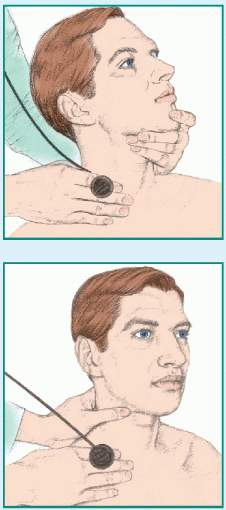A vesicular rash may be mild or severe and temporary or permanent. It can result from infection, inflammation, or allergic reactions.
MEDICAL CAUSES
♦ Burns (second-degree). Thermal burns that affect the epidermis and part of the dermis cause vesicles and bullae along with erythema, swelling, pain, and moistness.
♦ Dermatitis. In contact dermatitis, a hypersensitivity reaction produces an eruption of small vesicles surrounded by redness and marked edema. The vesicles may ooze, scale, and cause severe pruritus.
Dermatitis herpetiformis, a skin disease that is most common in men between ages 20 and 50 (and is occasionally associated with celiac disease, organ malignancy, or immunoglobulin A immunotherapy), produces a chronic inflammatory eruption marked by vesicular, papular, bullous, pustular, or erythematous lesions. The rash is usually distributed symmetrically on the buttocks, shoulders, and extensor surfaces of the elbows and knees, but it may sometimes appear on the face, scalp, and neck. Other symptoms include severe pruritus, burning, and stinging.
In
nummular dermatitis, groups of pinpoint vesicles and papules appear on erythematous or pustular lesions that are nummular (coinlike) or
annular (ringlike). The pustular lesions commonly ooze a purulent exudate, itch severely, and rapidly become crusted and scaly. Two or three lesions may develop on the hands, but the lesions typically develop on the extensor surfaces of the limbs and on the buttocks and posterior trunk.
♦ Dermatophytid. This allergic reaction to a fungal infection produces vesicular lesions on the hands, usually in response to tinea pedis. The lesions are extremely pruritic and tender and may be accompanied by fever, anorexia, generalized adenopathy, and splenomegaly.
♦ Erythema multiforme. This acute inflammatory skin disease is heralded by a sudden eruption of erythematous macules, papules and, occasionally, vesicles and bullae. The characteristic rash appears symmetrically over the hands, arms, feet, legs, face, and neck and tends to reappear. Although vesicles and bullae may also erupt on the eyes and genitalia, vesiculobullous lesions usually appear on the mucous membranes— especially the lips and buccal mucosa—where they rupture and ulcerate, producing a thick, yellow or white exudate. Bloody, painful crusts, a foul-smelling oral discharge, and difficulty chewing may develop. Lymphadenopathy may also occur.
♦ Herpes simplex. This common viral infection produces groups of vesicles on an inflamed base, most commonly on the lips and lower face. In about 25% of cases, the genital region is involved. Vesicles are preceded by itching, tingling, burning, or pain; develop singly or in groups; are 2 to 3 mm in diameter; and don’t coalesce. Eventually, they rupture, forming a painful ulcer followed by a yellowish crust.
♦ Herpes zoster. A vesicular rash is preceded by erythema and, occasionally, by a nodular skin eruption and unilateral, sharp pain along a dermatome. About 5 days later, the lesions erupt and the pain becomes burning. Vesicles dry and scab about 10 days after eruption. Associated findings include fever, malaise, pruritus, and paresthesia or hyperesthesia of the involved area. Herpes zoster involving the cranial nerves produces facial palsy, hearing loss, dizziness, loss of taste, eye pain, and impaired vision.
♦ Pemphigoid (bullous). Generalized pruritus or an urticarial or eczematous eruption may precede the classic bullous rash. Bullae are large, thick walled, tense, and irregular, typically forming on an erythematous base. They usually appear on the lower abdomen, groin, inner thighs, and forearms.
♦ Pemphigus. In chronic familial pemphigus, groups of tiny vesicles erupt on normal skin or mucous membranes. The vesicles are thin walled, flaccid, and easily broken, producing small denuded areas that become covered with crust and typically itch and burn. The eruption remits spontaneously but recurs.
Pemphigus foliaceus usually develops slowly and may begin with bullous lesions, commonly on the head and trunk. As these lesions spread to other areas, they become moist, scaly, and foul smelling. Nikolsky’s sign is present, and denudation of lesions results in extensive erythema, with large, loose scales and crusts. Pruritus and burning are common.
Pemphigus vulgaris may be acute and rapidly progressive or chronic. The typically flaccid bullae may be tender or painful and large or small. When they rupture, denuded skin exudes a clear, bloody, or purulent discharge. Commonly, the bullae first erupt in a specific location, such as the mouth or scalp, and eventually become widespread. Nikolsky’s sign and pruritus may be present.
♦ Pompholyx (dyshidrosis or dyshidrotic eczema). This common, recurrent disorder produces symmetrical vesicular lesions that can become pustular. The pruritic lesions are more common on the palms than on the soles and may be accompanied by minimal erythema.
♦ Porphyria cutanea tarda. This disorder, resulting from abnormal porphyrin metabolism, produces bullae—especially on areas exposed to sun, friction, trauma, or heat—and photosensitivity. Papulovesicular lesions may evolve into erosions or ulcers and scars. Chronic skin changes include hyperpigmentation or hypopigmentation, hypertrichosis, and sclerodermoid lesions. Urine is pink to brown.
♦ Scabies. In this disorder, mites that burrow under the skin cause small vesicles to erupt on the webs of the fingers, wrists, elbows, axillae, and waistline; the glans, shaft, and scrotum in males; and the nipples in females. The lesions are a few millimeters long, with a swollen nodule or red papule that contains the mite. Pustules and excoriations may also occur. Associated pruritus worsens at night and with inactivity and warmth.
♦
Smallpox (
variola major). Initial signs and symptoms include high fever, malaise, prostration, severe headache, backache, and abdominal pain. A maculopapular rash develops on the mucosa of the mouth, pharynx, face, and forearms and then spreads to the trunk and
legs. Within 2 days, the rash becomes vesicular and later pustular. The lesions develop at the same time, appear identical, and are more prominent on the face and extremities. The pustules are round, firm, and deeply embedded in the skin. After 8 to 9 days, the pustules form a crust, which later separates from the skin leaving a pitted scar. Death may result from encephalitis, extensive bleeding, or secondary infection.




